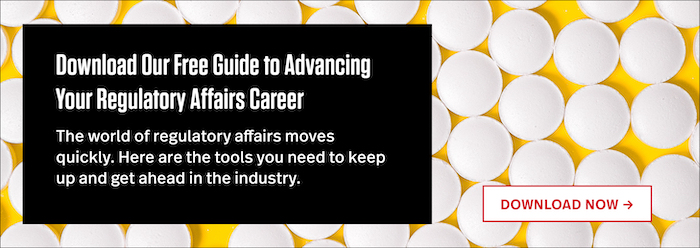Northeastern University lecturer Jeff Shiffman describes the critical role regulatory affairs professionals play in bringing a new medical device to market.
The medical device industry plays a key role in the healthcare ecosystem by providing innovative solutions that improve patient outcomes. Every company seeks to innovate, whether through iterative updates to existing technology or by developing new devices that could offer a more effective treatment to a particular disease or condition.
Regulatory affairs professionals serve a critical function throughout a medical device’s product lifecycle—leading premarket strategy, drafting regulatory submissions, and ensuring postmarket compliance. Here’s a closer look at each of those phases.
Download Our Free Guide to Advancing Your Regulatory Affairs Career
Learn how to navigate the discipline and accelerate your regulatory career.
Regulatory Affairs Responsibilities Throughout the Product Lifecycle
Premarket Regulatory Strategy
As product developers work to bring concept to reality, the regulatory affairs professional plays an important role, advising the team on appropriate regulatory strategies to ensure the product can be legally marketed. From the earliest meetings, regulatory affairs must advise the product team on how various decisions may affect the type of regulatory submission required, as well as associated timelines.
For products that will be distributed internationally, regulatory affairs must also coordinate with regional teams to ensure the product has a global regulatory strategy. To be effective in this role, the regulatory affairs professional must understand the international regulatory requirements the device will be subject to and ensure that the product development team considers these international requirements as they test and validate the device.
Marketing Applications
When product design is completed and a company is ready to market the device, the product development team relies on regulatory affairs to draft a successful marketing submission. In the United States, the most common type of submission is a premarket notification, also known as a “510(k),” named for Section 510(k) of the Federal Food, Drug, and Cosmetic Act, which provides the U.S. Food and Drug Administration (FDA) with the legislative authority to regulate medical devices.
To complete a successful 510(k), regulatory affairs must identify a similar device already legally marketed, known as a predicate. The submission must then demonstrate that the new device is substantially equivalent to the predicate one. If no predicate is available, regulatory affairs must submit a premarket approval application, or PMA, to demonstrate that the device is safe and effective for its intended uses.
Regulatory affairs is also responsible for reviewing all product labeling associated with the product to ensure all claims are consistent with the approved intended use. Marketing claims are key for device sales teams to differentiate your company’s product from that of a competitor. But any claims that speak to a use that has not been cleared or approved by the FDA puts the company at risk of receiving a Warning Letter for misbranding. As a result, medical device companies rely on their regulatory affairs teams to ensure all materials associated with the device are appropriate.
Postmarket Surveillance
Medical device companies also rely on their regulatory affairs team after a device is cleared or approved. In the postmarket setting, the regulatory function is involved in device surveillance, ensuring that any adverse events or malfunctions are appropriately reported to FDA.
Postmarket surveillance reports enable companies to identify trends in complaint data and can act as a warning system when a device has an unintended effect. For instance, if a company receives several adverse event reports indicating an implanted device is causing unexpected pain weeks after surgery, it’s possible that there’s an issue with the device that is causing the pain. Regulatory staff review postmarket surveillance reports and work with the FDA to initiate voluntary recalls in these situations to prevent unintended harm to patients.
Medical Devices and International Regulatory Affairs
While interactions with the FDA are key in the United States, regulatory affairs must also work with international health authorities and regulators in each country their company decides to market its device. In some countries with less mature medical device regulations, marketing clearance or approval by the FDA can be relied upon to obtain clearance or approval.
Many countries throughout the world have their own medical device regulations, however, and regulatory affairs is required to understand the differences in global regulatory requirements to ensure that new products can be marketed. The global regulatory landscape is always changing, so successful regulatory affairs teams follow global trends and are aware of new regulations or programs.
Following international harmonization organizations, such as the World Health Organization or International Medical Device Regulators Forum, can help to monitor these global trends and understand how different health authorities are dealing with an issue. Additionally, participating in industry trade associations can allow regulatory professionals to connect with one another and work collectively as an industry to identify and shape policy trends.
Learn More
Regulatory affairs professionals play a key role in all phases of the product lifecycle. While each product they support provides essential knowledge and experience that can be leveraged in the future, every new product also represents a new challenge—making regulatory affairs a fulfilling career.
To learn more about advancing your career in regulatory affairs, including the skills and education required to get ahead, download our free guide below.







Related Articles
4 Ways to Stay Competitive in Regulatory Affairs
Emerging Trends in Regulatory Affairs in 2022
How to Stay Updated on Regulatory Changes